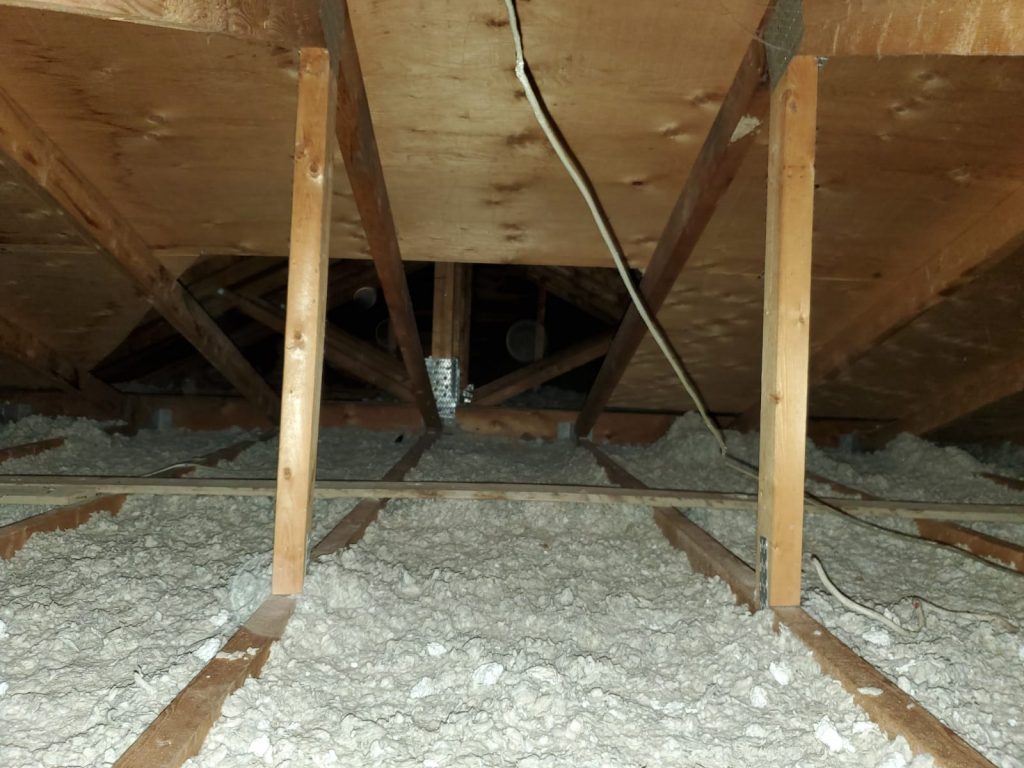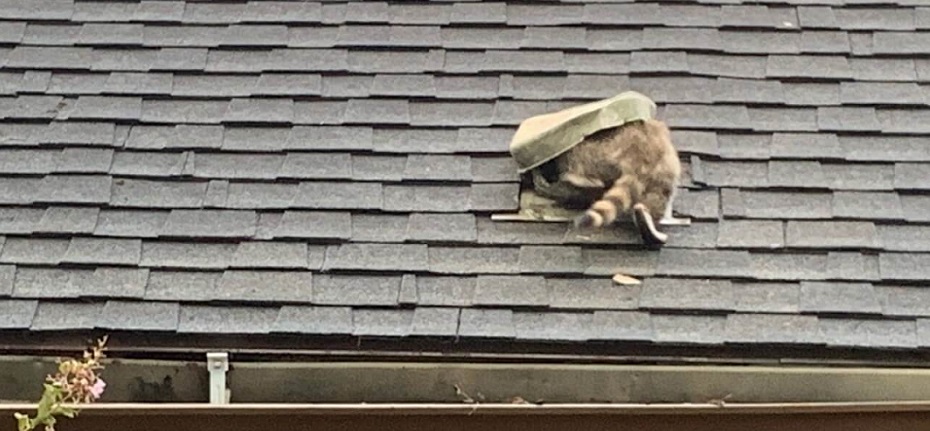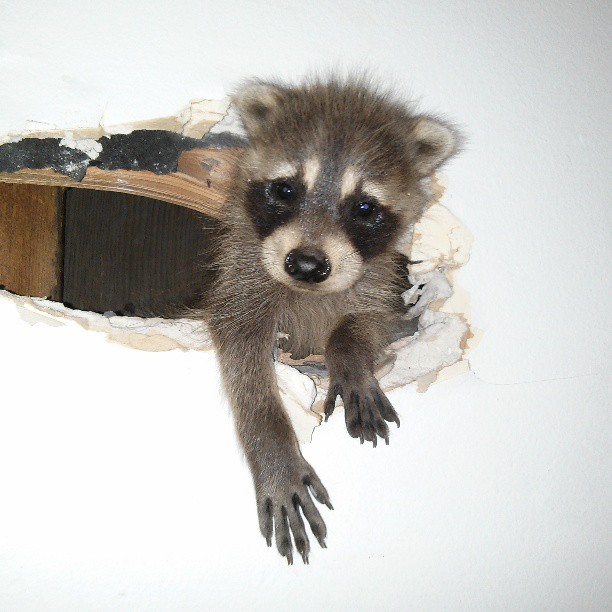Attics make great nesting options for many unwanted critters because they are warm and undisturbed by people. Most often these pests seek shelter in attics to survive harsh weather during winter or raise young during the spring.
The most common animals that live in an attic are raccoons, squirrels, bats, mice, and rats.
Why is there an animal in my attic?
The most common thought that comes to a person’s mind when realizing an animal is in their home is cleanliness. Although cleanliness can have a factor in why an animal is in your house, it is often not the reason for the invasion.
Since all living things need food, water, and shelter to survive, it is not uncommon for a critter to seek shelter on your property. As we continue to industrialize, the habitat available to all wildlife is continuously shrinking while the population of wildlife is increasing.
Signs you have an animal in your attic
- Noises at night – vocal noises, scurrying, scampering, thumps
- Damage to the outside of your property or an entry point – many animals will utilize construction gaps while others will cause damage to enter your home
- Unusual water leak – it is possible for animals to damage water lines or chew into them for a source of water
- Unexpected power issue – rodents like squirrels and rats are chewers and will chew anything to help trim their teeth
- An aroma of ammonia in or around your home – the longer an animal is in your attic, the more the animal will urinate, and you may start to smell it
What type of animal is in my attic?
If you do not physically see the animal, it can sometimes be very challenging to figure out what kind of animal you are dealing with.
How to identify the type of animal in your attic:
- How loud the noise is
- When the noise is occurring
- What kind of sounds do you hear
- What entry points are present
- What animal droppings are evident
What kinds of noises do you hear?
Scurrying and Scampering in the Attic or Walls
These noises indicate that you are probably dealing with rats, mice, or squirrels. If these noises occur during the night, you most likely have rats, mice, or flying squirrels, and if they occur during the daytime, you most likely have squirrels.
Loud Thumps During the Night
Louder noises during the night typically indicate you are dealing with a bigger nocturnal animal like a raccoon or possum.
Crying Noises during the Day
Unless a raccoon is sick/rabid, we typically only come across a momma raccoon active during the day if she has young, and baby raccoons are very vocal. Keep in mind, that raccoons have one litter per year and give birth in the Spring or early Summer.
Fluttering and/or Chirping
These noises indicate you are dealing with bats or birds. Bird noises will be more prevalent during the day while bats are active at night.
Vocalizations
Unless you are hearing crying during the daytime (potentially baby raccoons), a vocal noise like squealing or squeaking during the day would most likely belong to a squirrel or bird, while vocal sounds at night like growling, whimpering, or screaming can typically be attributed to a raccoon.
Signs of animal infestation in the attic
When inspecting an attic, we look for the traces an animal leaves behind. Droppings, footprints, and destruction are the most common animal signs we spot.
- Droppings
- Raccoons and possums will have droppings like that of a small dog
- Mice have droppings that are about 1/3-1/5 centimeters in length while rats and squirrels have droppings that are about 1-1.5 centimeters in length. The droppings of squirrels and rats can be very hard to tell apart, which is one reason why hiring a professional may be the best option for you.
- Snakes and birds both excrete in liquid form which contains white urea in it. Their droppings are commonly confused with one another, but a bird’s dropping will contain more urea, therefore, having more white coloration.
- Bat droppings are known as guano. They are mostly found around the entry point(s) that they are utilizing for entry. Guano is small, dark, and shiny. These droppings look like elongated pellets and are normally found grouped together. Please be aware that breathing guano is extremely dangerous.
- Tunneling
- When dealing with mice, rats, and even flying squirrels, you will often see tunneling in the insulation of an attic because insulation makes for a great nesting material. The tunneling will look like small holes that are as big as 3 inches in diameter.
- Prints
- Another indicator that animals will leave behind are paw prints on your duct work. Possums and raccoons have the biggest prints. They each have five fingers, but the palm of a possum’s print is more triangular. On the other hand, squirrels and rats have much smaller prints with their front feet having four toes and their hindfeet having five.
- Debris
- Squirrels will often collect acorns and leave behind shells in the attic space, which is an easy way to tell when you are dealing with squirrels. Squirrels will also bring nesting material into an attic. Take into account, you may have more than one animal type in your attic space.
- Rub Marks
- Animals like rats, mice, squirrels, and bats will leave behind rub marks around the openings that they utilize for entry. The rub marks will be brown to dark brown in color. The more the trails have been utilized, the darker these rub marks will be.
- Snake Skin
- Understandably, finding a snakeskin in an attic indicates you have had a snake in your attic, but there is usually a reason why a snake is there in the first place. A good portion of a snake’s diet consists of rodents and small mammals which suggests the snake may have been or may be in your attic searching for that food source.
- Damages
- You may find chewing on pipes or wires in your attic. Many animals will also destroy any personal belongings that you store in your attic.
How can an animal get into my attic?
Animals can enter your home through many different locations. The most common areas where we see animals entering are soffits, eaves, gable vents, roof returns, pipe stacks, any damaged areas on a property, and even any construction gaps. In fact, rats can fit through entry points as small as the size of a quarter, and mice can fit into a gap just over ¼ of the size of a quarter.
Animals can even enter your home if there is not an entry point present. Raccoons are tenacious, resourceful, and strong. If they want to use your home as shelter, they will use their hands to create an opening. Raccoons can tear apart shingles and break through the plywood. Rodents like squirrels, mice, and rats constantly gnaw. Rodents easily create entry holes by gnawing through materials like wood, pipes, plastic, metal, brick, and electrical wires.
Prevent animals from entering your attic by triming trees that are near your house, keep yard tidy and free from debris, and have a professional perform an inspection.
Brandon Thorsell, District Manager Toronto
Can I DIY Animal in Attic Removal?
You are certainly welcome to tackle a DIY wildlife removal project. Who wouldn’t want to save money?
First, make sure you have the proper PPE to enter an attic/handle an animal. Then, identify the animal in your attic, trap/remove the animal(s), and ensure all animals are removed from your attic.
Next, seal all entry points on your home. Do not seal an animal into your attic because this will cause the animal(s) to panic, and in turn, it will cause more destruction.
Finally, you will need to disinfect all contaminated areas of the attic to remove any bacteria associated with the animal’s waste. Alternatively, you can remove and replace your insulation. In addition, please keep in mind that there are different laws in each state when handling different animals.
How much does it cost to remove an animal from an attic?
The longer an animal issue goes unresolved, the more severe the problem will become. The amount of destruction, feces, and urine in your attic will continue to increase. Animal issues can also become hazardous. It is likely the longer the anima lives in your attic the more expensive it will be to solve the issue.
We recommend calling a wildlife professional as soon as you see or hear any signs of animal activity.
The wildlife removal process can greatly vary in price depending on the situation as there are many different factors that go into the pricing.
First, we need to remove any animals from your attic. Then, we seal any entry points into your home/attic space. Finally, we provide a solution catered to what works best for you and your unique animal situation.
If we need to trap animal(s) in one small attic space and seal 1 entry point, the cost will be much less than a home where we must trap in 3 attic spaces and seal 10 entry points. We provide fair pricing to all our customers, and we want to resolve your issue in the most cost-effective way while providing you with the best service possible.
Who should I call to get rid of the animal in the attic?
Due to the dangers of animal removal like entering attics/crawl spaces, climbing ladders, roof work, and chemical handling, we highly recommend you find a company that is licensed and insured. You also want to be sure the company you choose specializes and is knowledgeable in the animal you are dealing with.
A professional will be able to educate you, walk you through the entire animal removal process, answer any questions or concerns you may have, and provide you with additional tips for your home.


